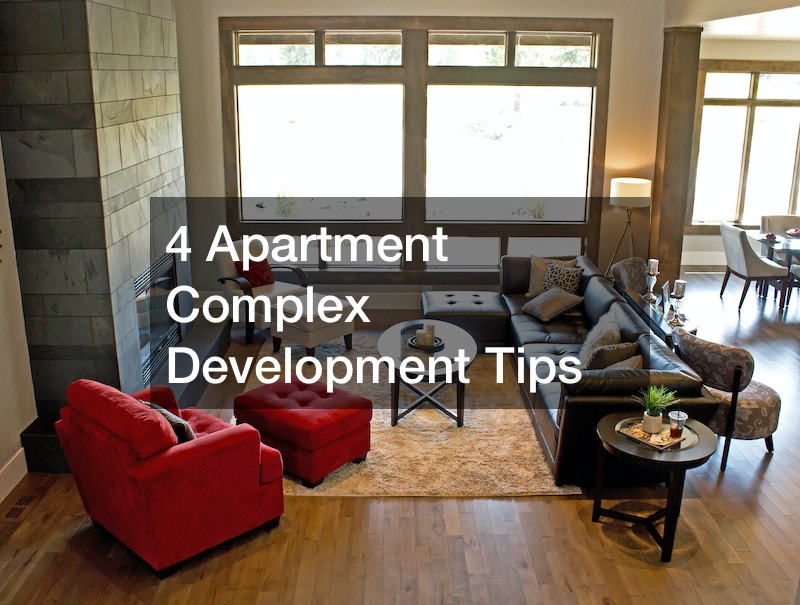
When developing an apartment complex, expected challenges require a strategy to overcome. You will likely encounter zoning issues and city regulations that complicate the process. This is because it is a big project that involves plan changes and coordination with other partners to be successful. Let’s look at 4 apartment complex tips.
1. Prior Planning

On one of the 4 apartment complex tips is to consult with local governments and State Housing Agencies to get guidelines and current building data. This information will help your architect and engineers in designing a state-approved building. Liaise with local elected officials and citizens to garner their support. Have consultations with land planning commissions and staff from the local government.
Conduct soil tests, environmental assessments, and site surveys. Consider existing zoning conditions, available child care services, and modes of transport. These assessments will give you insight into any hidden costs, soil conditions, environmental conditions, and easements that will affect your overall plan.
After consultations with the local land planning commission or the organized neighborhood property owners, the final design must be advised. They will help you establish and adhere to conceptual design guidelines. This includes, but is not limited to, parking standards, type of storage containers, exterior materials, landscaping, floor plans, and lighting. This step cannot be skipped because housing should complement existing structures in the area.
Once all key individuals have approved, secure the apartment complex development project funding. To qualify for private and public financing, you must complete and submit a proforma and cash flow analysis.
The housing firm you’re working with should help determine whether your project requires a construction manager, developer, or owner’s representative. Then you may assemble the project team, including a general contractor, architect, accident attorney, lender, planner, and building owner. It is best to consult with established firms instead of temp agencies for such long-term projects.
To complete the final development plan, ensure the use policies have been approved, you have sufficient financial commitments, construction documents, and appropriate licensing and permits. Work with a trustworthy developer because he is responsible for hiring subcontractors, crane rental services, meeting local occupancy standards, and supervising construction. His role as manager will be necessary and continue for one year after the apartment complex achieves full occupancy.
2. Factor in Time

Another one of the 4 apartment complex tips is to do a proper and thorough inspection of the designated site. Doing so will help determine if the intended apartment complex design can be built on the site. You need to check the zoning and the land use policy.
Confirm the residential proximity slopes, open space, densities, and setbacks, among other zoning criteria, can be achieved. Ensure that the site planner has all details in this regard. Assess the capacities of the available utilities and confirm that they suffice in supporting the site plan.
Check the pipe transportation systems in the zone to ensure sufficient drainage to and from the site. Become intimately familiar with the area around the intended construction zone. This includes involving the neighbors through consultations and sharing impactful project details. Getting the community on board is the first step to ensuring the apartment complex project will succeed.
Researching your area demands that you understand your future tenants. Given that the potential of return on investment rests with them, building the project with them in mind is vital. Depending on the surrounding facilities, you can expect different tenants who require specific needs.
For example, if you build close to a university, you can be sure that the college students will be highly interested in the apartment. Therefore, when designing and developing the apartment complex, you can implement certain features that optimize it to the students’ preferences, needs, or wants.
As you get acquainted with the neighborhood, remember to learn about the local laws, compliance requirements, and building regulations. There are long processes involved when applying for a building permit. This is especially true if you are constructing an apartment complex for students or low-income citizens. Investigate early on to ensure the project starts on time and prepare your requirements.
Once all the details are ready, and requirements are submitted, determine how long the project will take. Of course, this is based on the size of the building, the number of units, legal hoops, and the unique aspects of the location. An apartment building construction project takes a little over 13 months. This estimate may differ based on your resources and local conditions, but it is an excellent timeframe to work with.
Another factor in the time management of your project is finding the right partner. It is mandatory to work with a reliable partner for a big project, such as developing an apartment complex. They will help you through the processes discussed above and will be instrumental in expediting the set timeline.
Planning for success means working with a construction company that knows the site location. This partner must be open, transparent, and dedicated to seeing this project through. To ensure you are protected legally, check that they have registered with an occupational accident insurance company. Construction sites are hazardous, and anything could happen. Insurance cover for the workers at your site ensures that the project can go on in the event of an incident.
Other partners on your list will be architects, sub-consultants, and engineers. Ensure you overcommunicate your design ideas and have many briefings to confirm agreement. This action will save you unpleasant surprises such as building or plumbing design changes affecting the construction plans.
3. Implement Design

The third tip in the 4 apartment complex tips is to get your architect to draw the site plan. Conduct due diligence by engaging the engineer to troubleshoot the project. Have preliminary grading plans to ensure the success of your apartment complex. If the grading is incorrect, the outcome will be a poorly functioning, hard-to-maintain building that may result in disgruntled tenants or attract ADA lawsuits.
To mitigate this challenge, have regular grading work sessions with all your design partners. Create room for amenities, utilities, and extras early on and develop the plan around them. Factors such as parking, wastewater storage tanks, and site circulation should be well thought out and carefully included. Pre-coordinating all the elements early saves time and money because issues are identified and dealt with as they occur instead of later.
At every stage, be clear and concise in communicating the level of detail expected. That is the only way to ensure project deliverables are produced as desired. For this to run smoothly, you need the help of an excellent sub-consultant.
Another important job of sub-consultants is the monitoring of off-site improvements. This comprises any changes in electric and gas easements. These changes are out of your team’s control and will significantly impede the development of your apartment complex. A good consultant will keep a close eye on any off-site improvements and pursue solutions to any changes that prove to be project killers.
Understanding and keeping updated on all the nitty gritty changes to your development project are vital. After the draft plan, changes will occur in the implementation, which is only submitted later. To ensure you don’t miss anything, keep in close communication with your architect, sub-consultants, and engineers.
Proactively ask about any changes and make updates on your initial plan accordingly. Understand the building thoroughly and ask multiple questions to clear up any foggy details. Do not make assumptions; instead, work with facts.
Gathering all relevant details of the apartment complex will help you design a complimentary exterior. The best way to succeed in this element is to hire expert partners from the same firm. Working with one firm makes accountability and feedback easier to track. A united team will work cohesively and better spot and mitigate shortfalls.
Keep your apartment complex design simple, buildable, and efficient. A good plan will keep costs low and minimize wastage. Create and incorporate grading solutions to retain walls, get earthwork balance and minimize building splits.
4. Fun Outdoors

The fourth tip in the 4 apartment complex tips is to know that designing apartment complex projects requires incorporating vibrant and specific designs to attract tenants. Spaces designed thoughtfully and practically guarantee that tenants arrive faster and that their stay is blissful.
Please pay attention to the first impression the tenants will get when they arrive. This means focusing extra on the lobby to make it pleasing and elegant. Keep in mind your target market and incorporate pallets, patterns, and furnishings.
If you expect retirees or people aged 55, use neutral pallets with simply elegant furnishings. For the millennials, go big with bold color patterns and trendy organic furnishings. Do your research to use the correct finishes, fixtures, textures, and colors that resonate with the target audience.
Blend the indoors with the outdoors because many residents use these outdoor spaces to host parties and intimate get-togethers. When your outdoors are artfully designed and highly functional, this creates significant value for residents.
The furniture you choose should not be familiar or complicated, especially for outdoor functionality. You can create fun socializing arrangements by adding outdoor drink rails that divide the spaces and invite tenants to mingle. Discover various dock installation designs and trends to make your apartment complex futuristic.
You may cozy up the outdoor setting by adding a firepit for those incredible bonfire nights. This addition will enhance your overall design and offer tenants a place to gather. Factor in the daytime setting as well. The sun in summer can be scorching, so think about shade protection. You may consider outdoor umbrellas, cabanas, or colorful shade sails.
Adding lights to a cabana or using a bold color for sun sails will give your apartment complex an edge over others and create a fantastic central hub for entertainment and socializing. Believe it or not, these seemingly small elements communicate thoughtfulness, and tenants will be drawn to your development.
Think about adding a clubhouse to your apartment complex design plan. This space will serve as an extension to your tenants’ apartment. Do away with the dated furniture and old-fashioned board games to make it more fun and interactive. Try innovations such as stainless steel fabrication in making your furniture pieces.
The trend has transitioned to large flatscreen TVs, gaming equipment, retro games, and activities. Shuffleboard and ping pong tables create a fantastic game room for more socializing. With these pieces in your design, your clubhouse will be a hub for fun, active and lively interaction and community engagement.
Another design idea to consider is a gym. Many people today are concerned about their health and take steps to enroll in a gym to keep fit. However, apartment complex gyms are more than just treadmills, bikes, and ellipticals. Developers go an extra effort to add steam rooms, saunas, and spa services.
If you have the budget, you can create separate rooms for special activities such as yoga, pilates, Crossfit, or spinning. Ensure to keep the designs artful and thoughtful. These spaces are recreational and should inspire the residents to engage in them. What’s more, you may earn revenue from them if someone decides to start a paid program at the apartment complex.
To set your fitness center apart from the average gym rooms in the town, use bold and inspiring colors like blues, yellows, and oranges. Infuse character and personality into these spaces by incorporating unusual tiles or decorative metalwork. Motivate and stimulate senses by adding black and white photography.
Aside from the 4 apartment complex tips, you should remember that since the pandemic, more people have been working remotely. Business centers have become increasingly sought-after amenities in an apartment complex because they provide productive spaces away from the distraction of children or Netflix. These spaces must have wi-fi and tasteful partitions for some privacy.
It is vital to produce user-focused buildings to compete and thrive in the highly competitive industry of real estate developments. Using the 4 apartment complex tips discussed here will help you attract your ideal tenants because they can appreciate the value you bring. More importantly, your investment in this long-term asset will be secured and insured against any legal action.


